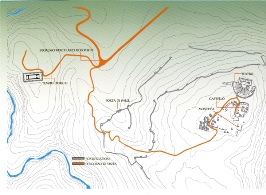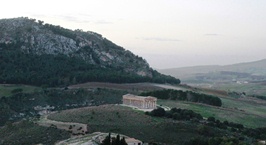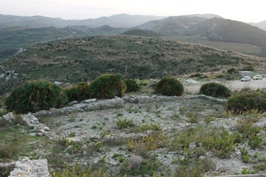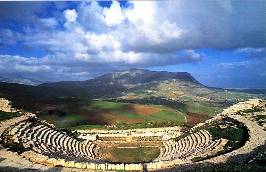Segesta
[tp not_in=”de,en,fr”]
Uno dei posti più belli del mondo per la meraviglia del suo tempio e del suo teatro risalenti a circa il V sec. a.C. Segesta fu una delle più importanti città siciliane del lontanissimo passato ed ancora oggi i suoi ruderi affascinano i visitatori. Forse venne fondata dal popolo degli Elimi, verso il 1000 a.C., che la leggenda vuole fossero gli scampati della guerra di Troia. Segesta non fu mai una città greca vera e propria mantenendo sempre una spiccata individualità. Anzi: si alleò spesso contro i greci di Sicilia e quando arrivarono i romani fu tra le prime città a diventarne amica. Segesta arricchisce la sua immensa bellezza archeologica con quella paesaggistica. Essa, difatti, si trova ancora oggi dentro i campi agricoli di questa parte di Sicilia in un paesaggio che sembra immutato.
La visita inizia dal basso, dove è il tempio , tra i più suggestivi al mondo. Vi si arriva assorbendone pian piano l’immensità, con le colonne che lentamente si “divorano” lo spazio visivo.
E’ scenograficamente perfetto, da dovunque si osservi. Questo edificio del V secolo a.C. è ancora oggi tutto là, perfetto, fuso nel paesaggio collinare della zona. Manca di cella (il luogo dove si poneva la statua della divinità) e di tetto ed il dibattito sul perché di queste assenze ha fondamentalmente creato due correnti di pensiero: quelli che dicono che esso non venne mai completato; e quelli che pensano che il tempio era proprio così. Ovvero, un recinto sacro, non un tempio classico siceliota. E questa ipotesi è suffragata dal fatto che Segesta non fù mai una vera e propria città greca, ma ne subì molto l’influenza.
Lasciato il tempio si sale per monte Barbaro, intravedendo resti di cinta muraria. Giunti in cima (440 m) è il teatro (foto), esemplare magnifico di costruzione ellenica del IV-III secolo a.C., in parte scavato nella roccia ed in parte no. Al solito, il paesaggio spazia all’infinito dalla sua cavea a sette file.
In cima alcuni sedili sono lavorati, come fossero poltroncine d’onore.
Poco fuori il teatro sta venendo alla luce un’ampia zona ricca di costruzioni, in questa parte di Segesta che era evidentementel’acropoli cittadina. Si mescolano elementi di diverse epoche dall’ante Cristo al medioevo.
Sempre nei pressi del teatro sono i ruderi di un castello del 1200 di cui rimane il solo piano terra e dove sono individuabili la latrina (a sud-est), alcune stanze a meridione con pavimenti in cocciopesto eccetera..
Nei pressi è una moschea (foto) di origine araba (IX-XII secolo ?), praticamente l’unico esempio in Sicilia. E’ lunga 20 metri e larga 11 costruita in un’unica fase e con tecnica edilizia uniforme (blocchi di calcare e terra usata come legante). Era in origine divisa in due navate, parallele al muro della qibla (che indica la direzione della Mecca e della Ka’ba, ovvero la direzione verso il quale un fedele si deve rivolgere per pregare), che si trova a meridione. Proprio al centro di questo muro, si apre la nicchia del mihrab, elemento presente in tutte le moschee antiche e moderne, di forma rettangolare.
A questa stessa comunità si possono anche attribuire alcune abitazioni ed il cimitero di rito musulmano rinvenuto dietro la cavea del teatro.
Poco fuori le mura, in contrada Mango, è un santuario del VI secolo a.C. la cui mole doveva essere imponente. I pochi ruderi testimoniano la probabile presenza di un recinto sacro (temenos) dentro il quale si sviluppavano diversi, maestosi, edifici cultuali.
Segesta è ancora in buona parte da scoprire. E questo la rende veramente ancora più affascinante.
[/tp]
[tp lang=”de” only=”y” not_in=”it,fr,en”]
Segesta Segesta ist einer der schönsten Plätze der Welt, bekannt für seinen wunderbaren Tempel und sein Theater, welche ca. auf das 5.Jh.v.Chr. zurückgehen. Segesta war eine der wichtigsten Städte der Geschichte und noch heute faszinieren ihre Ruinen die Besucher. Möglicherweise wurde es vom Volk der Elymer gegen 1000 v.Chr. gegründet. Die Legende erzählt, die Gründer wären die Überlebenden des Trojanischen Krieges. Segesta war nie eine rein griechische Stadt, sie hatte immer ihre eigene Individualität. Sie verbündete sich sogar oft gegen die Griechen Siziliens, und als die Römer kamen, war Segesta unter den ersten, die sich mit ihnen befreundeten. Die unermessliche archäologische Schönheit verbindet sich mit derjenigen der Landschaft. Segesta befindet sich auch heute noch mitten in Feldern und Weiden, die Landschaft scheint unverändert zu sein.
Segesta ist einer der schönsten Plätze der Welt, bekannt für seinen wunderbaren Tempel und sein Theater, welche ca. auf das 5.Jh.v.Chr. zurückgehen. Segesta war eine der wichtigsten Städte der Geschichte und noch heute faszinieren ihre Ruinen die Besucher. Möglicherweise wurde es vom Volk der Elymer gegen 1000 v.Chr. gegründet. Die Legende erzählt, die Gründer wären die Überlebenden des Trojanischen Krieges. Segesta war nie eine rein griechische Stadt, sie hatte immer ihre eigene Individualität. Sie verbündete sich sogar oft gegen die Griechen Siziliens, und als die Römer kamen, war Segesta unter den ersten, die sich mit ihnen befreundeten. Die unermessliche archäologische Schönheit verbindet sich mit derjenigen der Landschaft. Segesta befindet sich auch heute noch mitten in Feldern und Weiden, die Landschaft scheint unverändert zu sein.

Er wirkt als perfekte Bühne, von wo aus man auch schaut. Dieses Gebäude aus dem 5.Jh.v.Chr. ist noch heute da, harmonisch in den Proportionen, verschmolzen mit der Hügellandschaft der Umgebung. Es fehlt die Cella (der Ort, wo die göttliche Statue stand) und das Dach. Die Diskussion über das “warum” hat zu zwei Schlüssen geführt: 1. dass der Tempel nie fertig gestellt worden war; 2. dass der Tempel genau so war, also eine sakrale Abgrenzung und nicht ein klassischer sikeliotischer Tempel. Diese Hypothese wird durch die Tatsache bekräftigt, dass Segesta nie eine reine griechische Stadt war, jedoch grossen Einfluss hinnehmen musste.
Nach der Tempelbesichtigung steigt man auf den Monte Barbaro. Unterwegs sieht man die Reste der Umfassungsmauer. Auf dem Gipfel (440 m) angekommen, präsentiert sich das Theater (Foto), eine wunderschöne hellenistische Konstruktion (4.-3.Jh.v.Chr.), teilweise in den Fels gegraben. Normalerweise weitet sich die Landschaft ins Unendliche vom Zuschauerraum aus. Auf dem Gipfel sind einige Sitze bearbeitet, als wären es Ehrenplätze.
Wenig ausserhalb des Theaters ist eine weite Zone, reich an Bauten, ans Licht gekommen. In diesem Teil Segestas war offensichtlich die städtische Akropolis. Es mischen sich Elemente aus verschiedenen vorchristlichen Epochen bis zum Mittelalter.
Ebenfalls in der Nähe des Theaters sind die Ruinen eines Kastells aus dem Jahre 1200, von dem nur das Erdgeschoss bleibt. Unterscheidbar sind die Latrine im Südosten, einige Zimmer mit Ton-Mörtelböden (Cocciopesto) im Süden, etc.

Der gleichen Glaubensgemeinschaft kann man auch einige Wohnungen und den Friedhof zuweisen, der hinter dem Zuschauerraum des Theaters zum Vorschein gekommen ist.
Etwas ausserhalb der Umfassungsmauern, in der Contrada Mango, steht ein Santuario aus dem 6.Jh.v.Chr., dessen Ausmass imponierend gewesen sein muss. Die wenigen Ruinen zeugen von der möglichen Präsenz eines umgrenzten Bezirks eines Heiligtums (Temenos). Darin waren verschiedene mächtige Kultgebäude. In Segesta ist noch Vieles unentdeckt, und das macht es noch viel faszinierender.
[/tp]
[tp lang=”fr” only=”y” not_in=”it,de,en”]
Sègeste C’est un des lieux plus beaux au monde pour la beauté de son temple et de son théâtre (environ V siècle avant J.-C.). Ségeste fut une des plus importantes villes siciliennes du passé. Elle fut probablement fondée par le peuple des Elimi, vers 1000 avant Christ, qui selon la légende étaient les rescapés à la guerre de Troie. Ségeste fut souvent contre les grecs de Sicile et se lia d’amitié avec les romains.
C’est un des lieux plus beaux au monde pour la beauté de son temple et de son théâtre (environ V siècle avant J.-C.). Ségeste fut une des plus importantes villes siciliennes du passé. Elle fut probablement fondée par le peuple des Elimi, vers 1000 avant Christ, qui selon la légende étaient les rescapés à la guerre de Troie. Ségeste fut souvent contre les grecs de Sicile et se lia d’amitié avec les romains.

 Au sommet (440 m) est le Théâtre (photo), magnifique construction hellénique du IV-III siècle av. J. – C. Près du théâtre il y a les vestiges d’un château de 1200.
Au sommet (440 m) est le Théâtre (photo), magnifique construction hellénique du IV-III siècle av. J. – C. Près du théâtre il y a les vestiges d’un château de 1200.

[/tp]
[tp lang=”en” only=”y” not_in=”it,fr,de”]
Segesta
This is one of the most beautiful spots in the world with its marvelous temple and theater built around the 5th century BC.Segesta was long ago one of the most important Sicilian cities and it is still important today because it is so fascinating to visitors.Perhaps it was founded by the Elymian peoples, around 1000 BC. Legend has it that they were survivors of the Trojan War. Segesta was never really a true Greek city and always maintained its individuality. On the contrary, they always fought against the Sicilian Greeks (the Sicelioti) and when the Romans arrived, Segesta was one of the first cities they befriended. Segesta has preserved its ancient landscape. It is, in fact, still in the agricultural fields of this part of Sicily that seem unchanged.

 Leaving the Temple to climb Mount Barbaro, the remains of a wall can be seen. When you reach the top (440 m) you see theTeatro (photo) a magnificent example of Hellenic construction of the 4th-3rd century BC. Part of it is carved into the rock. As usual, the landscape stretches out endlessly from the auditorium and its seven rows of seats. At the top there are noticeably different seats for persons of honor.
Leaving the Temple to climb Mount Barbaro, the remains of a wall can be seen. When you reach the top (440 m) you see theTeatro (photo) a magnificent example of Hellenic construction of the 4th-3rd century BC. Part of it is carved into the rock. As usual, the landscape stretches out endlessly from the auditorium and its seven rows of seats. At the top there are noticeably different seats for persons of honor.
A little outside the theater we see arise a broad area rich in buildings, that, in this part of Segesta, was evidently the town’sacropolis. It is a mixture of elements from diverse time periods, BC to medieval.
Close to the theater are ruins of a castle from 1200 of which remains only the first floor and where there is an individual latrine (in the south-east), a few rooms in the southern part that have dark earthenware floors, eccetera.

At the muslim we can also attribute a few dwellings and the cemetery discovered behind the auditorium of the theater.
A little outside the wall, in the area of Mango, is the sanctuary of the 6th century BC, whose bulk had to be impressive. The few ruins are testimony to the probable presence of a sacred precinct (temenos) inside which were discovered various and majestic cult buildings.
There is still a lot to discover at Segesta and that makes it even more fascinating.
[/tp]
